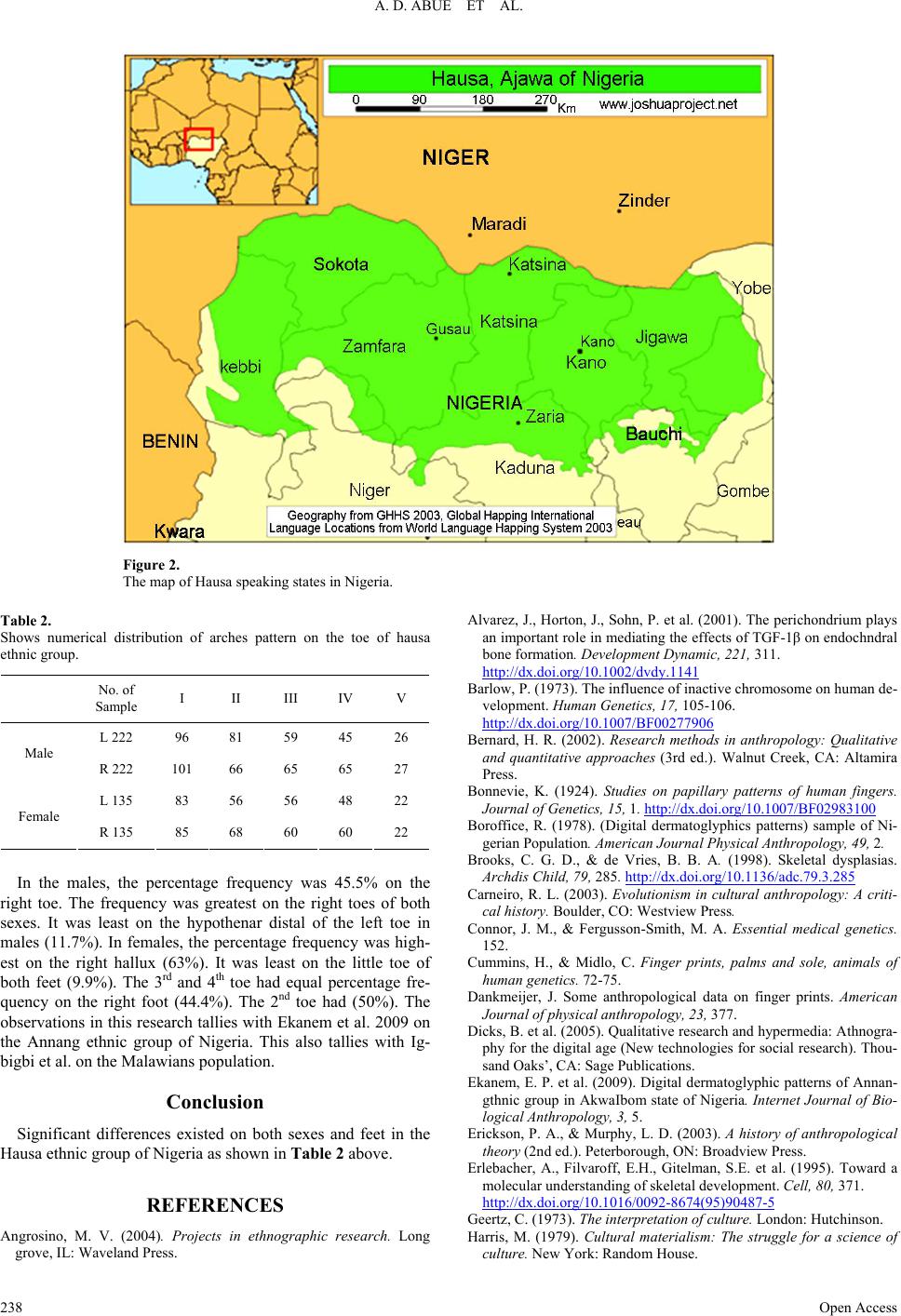
A. D. ABUE ET AL.
Figure 2.
The map of Hausa speaking states in Nigeria.
Table 2.
Shows numerical distribution of arches pattern on the toe of hausa
ethnic group.
No. of
Sample I II III IV V
L 222 96 81 59 45 26
Male
R 222 101 66 65 65 27
L 135 83 56 56 48 22
Female
R 135 85 68 60 60 22
In the males, the percentage frequency was 45.5% on the
right toe. The frequency was greatest on the right toes of both
sexes. It was least on the hypothenar distal of the left toe in
males (11.7%). In females, the percentage frequency was high-
est on the right hallux (63%). It was least on the little toe of
both feet (9.9%). The 3rd and 4th toe had equal percentage fre-
quency on the right foot (44.4%). The 2nd toe had (50%). The
observations in this research tallies with Ekanem et al. 2009 on
the Annang ethnic group of Nigeria. This also tallies with Ig-
bigbi et al. on the Malawians population.
Conclusion
Significant differences existed on both sexes and feet in the
Hausa ethnic group of Nigeria as shown in Table 2 above.
REFERENCES
Angrosino, M. V. (2004). Projects in ethnographic research. Long
grove, IL: Waveland Press.
Alvarez, J., Horton, J., Sohn, P. et al. (2001). The perichondrium plays
an important role in mediating the effects of TGF-1β on endochndral
bone formation. Develop m ent Dynamic, 221, 311.
http://dx.doi.org/10.1002/dvdy.1141
Barlow, P. (1973). The influence of inactive chromosome on human de-
velopment. Human Genetics, 17, 105-106.
http://dx.doi.org/10.1007/BF00277906
Bernard, H. R. (2002). Research methods in anthropology: Qualitative
and quantitative approaches (3rd ed.). Walnut Creek, CA: Altamira
Press.
Bonnevie, K. (1924). Studies on papillary patterns of human fingers.
Journal of Genetics, 15, 1. http://dx.doi.org/10.1007/BF02983100
Boroffice, R. (1978). (Digital dermatoglyphics patterns) sample of Ni-
gerian Population. American Jou r n a l Physical Anthropology, 49, 2.
Brooks, C. G. D., & de Vries, B. B. A. (1998). Skeletal dysplasias.
Archdis Child, 79, 285. http://dx.doi.org/10.1136/adc.79.3.285
Carneiro, R. L. (2003). Evolutionism in cultural anthropology: A criti-
cal history. Boulder, CO: Westview Press.
Connor, J. M., & Fergusson-Smith, M. A. Essential medical genetics.
152.
Cummins, H., & Midlo, C. Finger prints, palms and sole, animals of
human genetics. 72-75.
Dankmeijer, J. Some anthropological data on finger prints. American
Journal of physical anthropology, 23, 377.
Dicks, B. et al. (2005). Qualitative research and hypermedia: Athnogra-
phy for the digital age (New technologies for social research). Thou-
sand Oaks’, CA: Sage Publications.
Ekanem, E. P. et al. (2009). Digital dermatoglyphic patterns of Annan-
gthnic group in AkwaIbom state of Nigeria. Internet Journal of Bio-
logical Anthropology, 3, 5.
Erickson, P. A., & Murphy, L. D. (2003). A history of anthropological
theory (2nd ed.). Peterborough, ON: Broadview Press.
Erlebacher, A., Filvaroff, E.H., Gitelman, S.E. et al. (1995). Toward a
molecular understanding of skeletal development. Cell, 80, 371.
http://dx.doi.org/10.1016/0092-8674(95)90487-5
Geertz, C. (1973). The interpretation of culture. London: Hutchinson.
Harris, M. (1979). Cultural materialism: The struggle for a science of
culture. New York: Random House.
Open Access
238